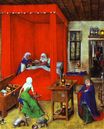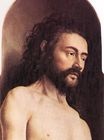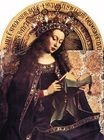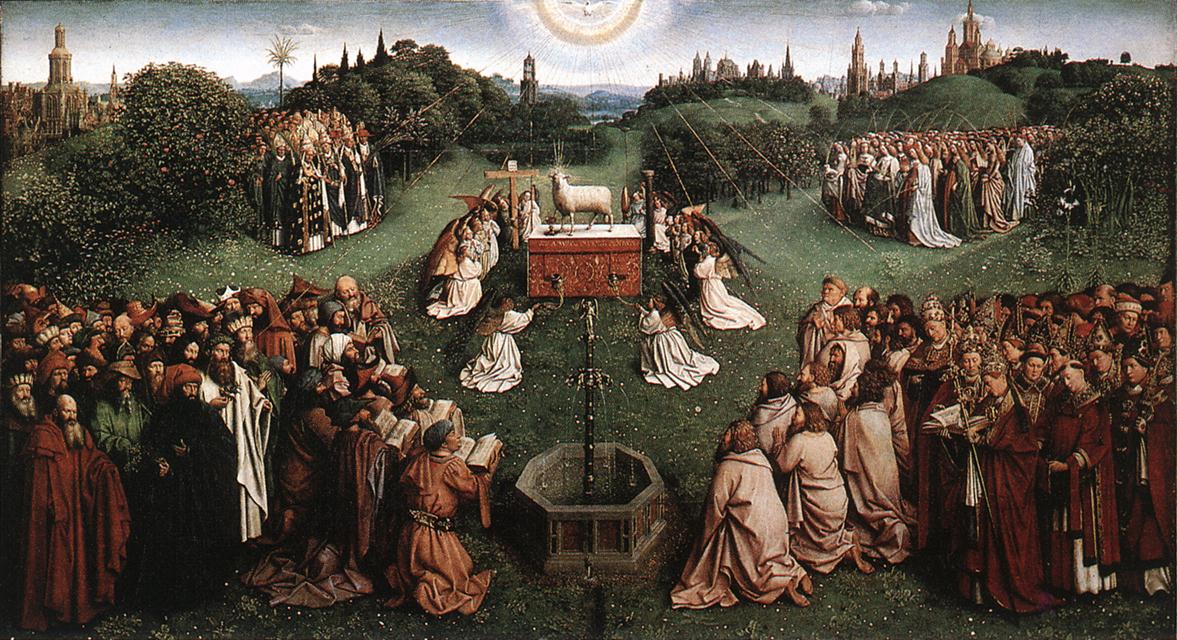Jan van Eyck - Adoration of the Lamb 1425-1429
 |
 |
 |
 |
 |
 |
 |

Adoration of the Lamb 1425-1429
137x243cm oil on wood
Ghent Altarpiece, Saint Bavo Cathedral, Ghent, Belgium
<< Previous G a l l e r y Next >>
From Wikipedia, the free encyclopedia:
The Ghent Altarpiece (or the Adoration of the Mystic Lamb, Dutch: Het Lam Gods) is a very large and complex 15th-century polyptych altarpiece in St Bavo's Cathedral, Ghent, Belgium. It was begun c. the mid-1420s and completed before 1432, and is attributed to the Early Netherlandish painters and brothers Hubert and Jan van Eyck. The altarpiece is considered a masterpiece of European art and one of the world's treasures.
Measuring 134.3 x 237.5 cm, the center panel has as its centerpiece an altar on which the Lamb of God is positioned, standing in a verdant meadow, while the foreground shows a fountain. Five distinct groups of figures surround altar and fountain. In the mid-ground two further groups figures are seen gathering; the dove of the Holy Spirit is above. The meadow is framed by trees and bushes; with the spires of Jerusalem visible in the background. Dhanens says the panel shows "a magnificent display of unequaled color, a rich panorama of late medieval art and the contemporary world-view." The iconography, suggested by the groupings of the figures, appears to follow the liturgy of All Saints' Day.
The lamb stands on an altar, and is surrounded by 14 angels arranged in a circle, some holding symbols of Christ's Passion, and two swing censers. The lamb has a wound on its breast from which blood gushes into a golden chalice, yet it shows no outward expression of pain, a reference to Christ's sacrifice. The angels have multicolored wings and hold instruments of Christ's passion, including the cross and the crown of thorns. The antependium on the upper portion of the front of the altar is inscribed with the words taken from John 1:29; ECCE AGNUS DEI QUI TOLLIT PECCATA MUNDI ("Behold the Lamb of God who takes away the sins of the world"). The lappets bear the phrases IHESUS VIA ("Jesus the Way") and VERITAS VITA ("the Truth, the Life").
A dove, representing the Holy Spirit, hovers low in the sky directly above the lamb, surrounded by concentric semicircles of white and yellow hues of varying luminosity, the outermost of which appear like nimbus clouds. Thin golden beams emanating from the dove resemble those surrounding the head of the lamb, as well as those of the three figures in the Deësis in the upper register. The rays seem to have been painted by van Eyck over the finished landscape, and serve to illuminate the scene in a celestial, supernatural light. This is especially true with the light falling on the saints positioned directly in front of the altar. The light does not give reflection or throw shadow, and has traditionally been read by art historians as representing the New Jerusalem of Revelations which in 21:23, had "no need of the sun, neither of the moon, to shine in it; for the glory of God did Lighten it".
The illumination contrasts with the natural and directional lighting of the four upper interior wings, and of each of the outer wings. It has been interpreted as a device to emphasize the presence of the divine and accentuate the paradise of the central landscape. The dove as the Holy Spirit, and the lamb as Jesus, are positioned on the same axis as that of God The Father in the panel directly above; a reference to the Holy Trinity.